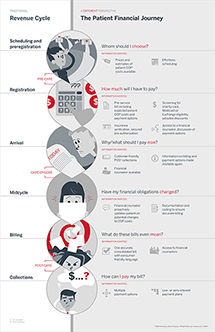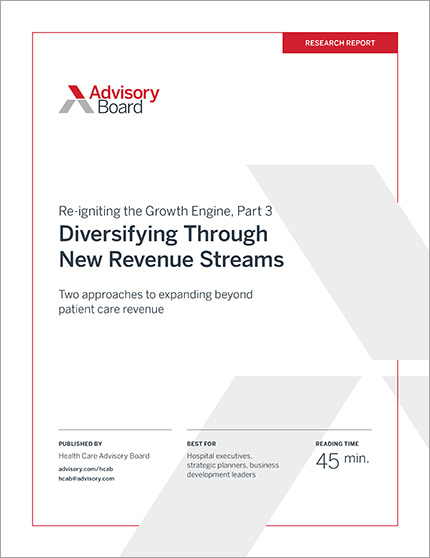Read Advisory Board's take: Why bad debt is rising—and three ways to fight back
Two for-profit hospitals owned by Alecto Healthcare Services are piloting a new way to ensure patients pay their outstanding medical bills: They're cutting the bills in half.
How the program works
Ohio Valley Medical Center (OVMC) and East Ohio Regional Hospital (EORH) decided to test the bill-reduction plan "to bring in income from people who are trying to do payments," according to Jose Guevara, revenue cycle director for the hospitals.
Under the plan, if a patient pays 50% of their outstanding medical bill, OVMC and EORH will forgive the remaining portion of the bill. Karin Janiszewski, the director of marketing and public relations at OVMC and EORH, said the offer applies to all medical bills incurred before 2019.
"It's a win-win for us," Janiszewski said. "We do, at least, get half of the fees. [Patients] are also able to make the payments instead of just saying, 'I'm not paying' or 'I've stopped paying.' Instead, they're saying, 'I'll give that a try.'" She added that the offer is appealing to patients "who were trying to pay the minimum they could—because they could not pay otherwise."
Janiszewski did not specify the exact dollar amount the hospitals have collected under the initiative. But she said, "We've collected a lot of money."
According to Guevara, the plan had worked well at other hospitals where officials were able to collect at least some of the outstanding fees rather than writing them off entirely. "It's a really good way to collect on old accounts," Guevara said.
The program was slated to end on Feb. 28, but due to its popularity hospital officials have elected to extend the offer until mid-March, Janiszewski said.
"We're also doing the same thing for labs and X-rays," Janiszewski said. "If [the patients] pay in full, they get 10-20% off. It's really encouraging people to try to pay" (Comins, The Intelligencer/Wheeling News-Register, 2/19; Ellison, Becker's Hospital CFO Report, 2/22).
Advisory Board's take

Robin Brand, Senior Director, Revenue Cycle Advancement Center
While hospitals may be able to raise revenue through these types of write-off initiatives, having to make these deals so long after care clearly isn't the best practice. It indicates that the hospitals weren't doing the things from the get-go—like providing a pre-service bill, connecting patients with a financial counselor, and introducing a payment plan—that allow patients to properly understand, plan for, and be more likely to pay, their bills.
“These write-off initiatives can also reinforce the idea that hospital charges are arbitrary”
These write-off initiatives can also reinforce the idea that hospital charges are arbitrary, which can ultimately hurt the perception of the hospital in the community (and potentially hinder future reimbursement).
Regardless, I understand that high levels of bad debt are the status quo at many hospitals. Hospitals' amount of uncompensated care has been rising each year, due largely to the rise of high deductible health plans, growing patient consumerism, shifting outpatient services, and overall price growth.
At the core of this shift is a concerning trend: Hospitals are relying more on patient financial obligations, and this is increasingly turning to bad debt. For instance, when analyzed over 700,000 patient accounts between FY 2008 and FY 2015, we found that the proportion of total commercial revenue expected to come from patient increased from 5 to 8% during this time. At the same time, the proportion of potential commercial revenue lost to bad debt quadrupled—from 1 to 4%.
Clearly, these high levels of bad debt are not desirable nor sustainable. And the solution, revenue cycle optimization, is not a new one. However, in today's era of slimming margins, it is simply too lucrative to explore. To achieve best-in-class revenue capture today, organizations must:
- Elevate revenue cycle's strategic value
In our research interviews with nearly 80 strategy officers from hospitals and health systems around the country, only six mentioned revenue cycle as a major area of strategic growth. Organizations cannot maintain this mindset. Rather, they must not think of revenue cycle as a cost center, but a strategic function that adds value to the whole organization. To begin, quantify the immediate and accretive revenue cycle optimization opportunity at your hospital so that you can articulate the benefits of an improved revenue cycle performance more clearly.
- Engage physicians as revenue cycle partners
Many physicians already feel overburdened with administrative tasks and hesitant to accept more responsibility in revenue cycle operations. Yet, innovative solutions can actually decrease their administrative responsibilities. For instance, when Piedmont Healthcare noticed that many coders had to keep checking documentation with physicians for accuracy, they shifted some of these coding specialists from the back-end to the start of the process, where they work with physicians to create a more accurate prospective MS-DRG. They've measured a 5:1 ROI on this prospective DRG coder.
- Build a robust patient financial navigation program
As patient financial obligations grow, it's increasingly important to help patients understand their medical bills and obligations. In a survey of 2,500 consumers with a medical bill, 70% reported that they were always or sometimes confused by their bills. The best way to help? A pre-service bill, which clearly identifies the patient's total obligation, explains each component in consumer-friendly language, includes a glossary of common billing terms, and reserves free space for billing staff to address patient questions and concerns.
These three best practices are just the tip of the iceberg of our recent work about how to create a patient-centered financial experience and reduce avoidable revenue erosion. To get more resources about improving revenue capture, make sure to review our Revenue Cycle Resource Library.
Then, for more on why revenue cycle should be a core component of your organization's growth strategy, read our new three-part series on Re-igniting the Growth Engine.
New report series: 10 strategies to re-ignite the revenue growth engine
Our three-part Reigniting the Growth Engine series walks through ten strategies to guide hospital and health system leaders on the road to effective long-term revenue growth.
The research explains the forces behind today’s margin challenge, provides a framework for comprehensive and efficient revenue growth, and features case studies of best-in-class organizations.
Part 1 | Reduce avoidable revenue erosion
Part 2 | Win increased share of lucrative patient volumes
Don't miss out on the latest Advisory Board insights
Create your free account to access 2 resources each month, including the latest research and webinars.
Want access without creating an account?
You have 2 free members-only resources remaining this month remaining this month.
1 free members-only resources remaining this month
1 free members-only resources remaining this month
You've reached your limit of free monthly insights
Become a member to access all of Advisory Board's resources, events, and experts
Never miss out on the latest innovative health care content tailored to you.
Benefits include:
You've reached your limit of free monthly insights



